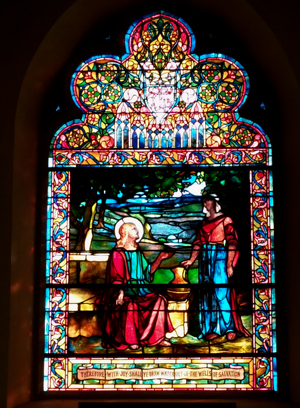

|
|
|
|
|
|
Hallo again to all. 
When we are in church of a Sunday, we like watching the progression of light through stained glass windows in the sanctuary. One rainy weekend on a long-awaited first visit to a certain cathedral, we were disappointed to find the large transept window depicting the Tree of Life had been removed for restoration. In its place were sheets of orange glass. We thought it a shame we couldn't view the Tree of Life until the rain stopped and the sun came out: the dias was bathed in warm deep golden light for the entire Mass. It is difficult to capture the visual experience in words. To us, the quality of the light and the way it rested on the altar that morning were the embodiment of how we have imagined the light from heaven fell on Jesus at his baptism as the words were spoken, 'You are my Son, the Beloved; with you I am well pleased'. One parish we regularly visit has a window uncommon both for its subject matter and for using this subject in its most prominent chancel window—above the altar. Created in the late 1800s in the style of John Lafarge, the window shows Jesus and the Samaritan woman together at the well as told in the Gospel of John (4:1-42). For a church's most prominent window above the altar, we are accustomed to seeing rose windows or windows depicting Jesus with and without his apostles, the Trinity, the Ascension, symbols of our Eucharist, or other Christian symbols. We rarely see stained glass featuring women who are not the mother of our Lord or some church benefactor's relative anywhere in the sanctuary, let alone above the altar. If you know some examples, please write and tell us. But in this particular church on a Sunday morning, we can watch the sun illuminate first Jesus, then the well and water jar, and finally the Samaritan woman. The opalescent glass changes color and depth as the sun travels across the window revealing something new each time we look. We especially like the verse from Isaiah (12:3) at the foot of this window. 
Elizabeth Webb writes, The wells of salvation, the water of God's gracious presence, are bottomless, endless. These are the waters that give life, restoring vibrancy to a world that is dying of thirst, and seeking wholeness for those overwhelmed by the floods of destruction. The water of forgiveness, of liberation from all that holds us in captivity, of refreshment of souls that are parched for grace, is the same water of which Jesus speaks to the Samaritan woman at the well...The water of salvation that flows with the very presence of God is coming again to the world in endless supply for our deepest need. The image of a quiet conversation and a shared drink of water between our Lord and the Samaritan woman provides plenty upon which to meditate. We find the scene in this altar window a nice counterpoint to the story of Doubting Thomas, the gospel passage for the Second Sunday of Easter in the Revised Common Lectionary. Usually, we are not like the Samaritan town folk who immediately believe when the woman tells them about her conversation with Jesus. We more frequently act like Thomas, needing to see things for ourselves rather than taking another's word. We don't like situations we cannot control. We definitely do not accept most difficult things without question. Having been affected by incivility in the workplace, in politics, and society in general, we have reached a point where we are not inclined to believe any reports from others about most things. And, after being shown the proofs we demand, we often feel foolish about our initial response of distrust or non-acceptance. We listened to the Gospel reading this morning and looked up at the altar window. We were struck by how Jesus engaged the Samaritan woman. A woman, a Samaritan woman, a woman ostracized by her town folk: thrice 'unclean'. She came across Jesus while doing a daily task, and he reached out to her. His words changed her life. In some ways, we see this Bible story as a model for how churches can interact with their communities. Do we wait to be asked before working in the community? Are we comfortable talking tête-à-tête with those we don't know? Do we treat those on the fringe of society with the kindness and respect we show to our friends and acquaintances? We hope we do, but we know we can do better. Please send us your thoughts. See you next week. No doubt about it.
| ||
This web site is independent. It is not official in any way. Our editorial staff is private and unaffiliated. Please contact editor@anglicansonline.org about information on this page. ©2015 Society of Archbishop Justus. Please address all spam to press@anglicansonline.org |